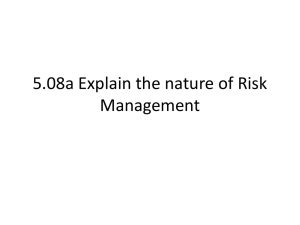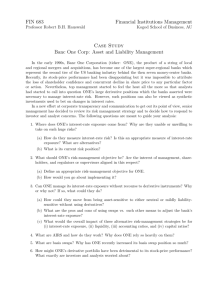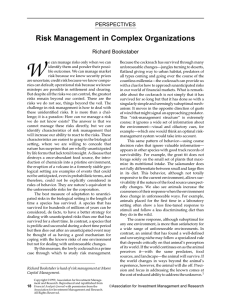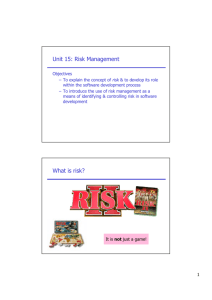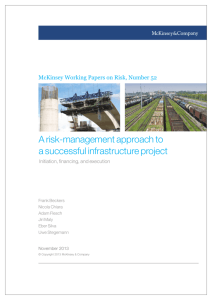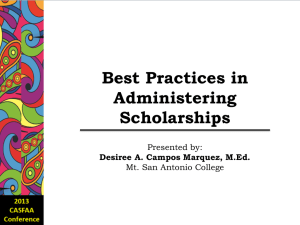Module 2 - Southern Early Childhood Association
advertisement
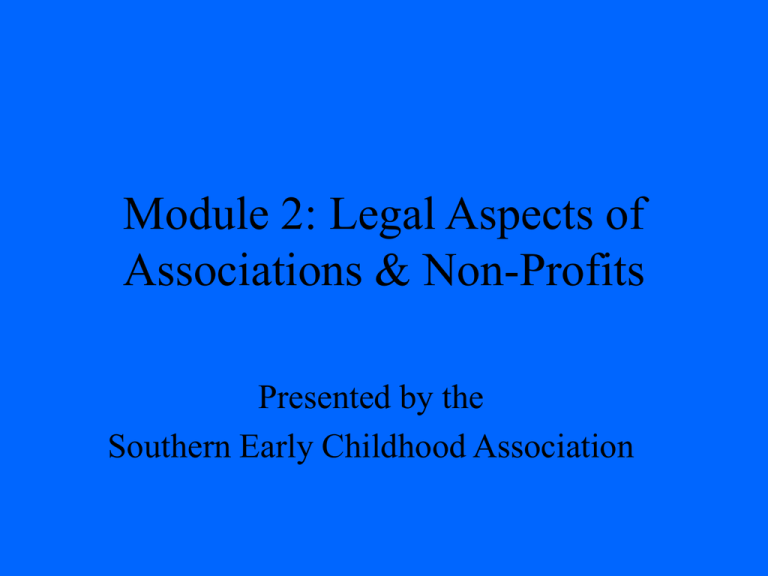
Module 2: Legal Aspects of Associations & Non-Profits Presented by the Southern Early Childhood Association Topics to be Presented…. • Legal aspects of association names • Association “Statement of Purpose” • Legal contracts (formation, enforcement, settling disputes) • Record retention policies • Association risk-management plans Your association’s name should… • Accurately reflect the nature and purposes of your organization • Protect the reputation of your association • Avoid confusion with another organization • Have a clear and concise acronym A statement of purpose is a general statement describing the reasons for which an association was formed and its intentions for the future. Examples of common purpose statements: • To promote the welfare of a group of members • To deal by lawful means with common problems or concerns • To act as an advocate before government bodies Two main guidelines for writing (or revising) your association’s Statement of Purpose: • Because a Statement of Purpose can restrict an association’s operations, the statement is best kept more general than specific. • An association’s Statement of Purpose should announce the organization’s intention to act consistently with its non-profit tax-exempt status and to observe all laws and regulations. * DISCUSSION * • Are your association’s legal name and Statement of Purpose written in the manner that best protects your organization? • Which aspects of the association name and Statement of Purpose are especially helpful to your organization, and which could you improve upon? • How does your organization require that such significant changes be made, and who has the authority to make them? Legal Contracts Contract: a voluntary understanding between two parties that creates a binding relationship between them As a result of a contract, each party has obligations and expects something in return. Three essential elements of a contract: • An offer by one party to take action or perform a service • An acceptance by a second party to receive that service • Consideration, or “payment” of some type for the service Your association may enter into a contract when… • • • • • • Renting or buying office space Purchasing office equipment or supplies Arranging for meetings or conventions Booking speakers or panelists Buying insurance Hiring accountants, authors, attorneys, researchers, or other consultants for the association’s use • Employing association staff and executives * DISCUSSION * In what types of legal contracts does your association participate? Guidelines for Forming Legal Contracts 1. 2. 3. 4. 5. Authority Legality Jurisdiction Assignment Modification Five Common Contract Mistakes (and How to Avoid Them!) 1. 2. 3. 4. 5. Failure to negotiate provisions Failure to understand all provisions Lack of specificity Lack of deadlines and penalties Failure to require parallel liability clauses * DISCUSSION * How much attention does your association pay to the terms of a contract? Be specific, and answer for the following types of contracts: a) Employment contracts b) Hotel and facility contracts c) Office management contracts Guidelines for Contract Disputes… 1. Written words reign supreme! 2. Use of outside sources to alleviate confusion 3. Court has more power with a verbal contract 4. $500, 1+ years 5. Damages Characteristics to Look for When Choosing Legal Counsel • Legal competence • Ability to work productively with association staff and officers • Fees within the price range of the association • Knowledge to protect the association against potential liability Guidelines for Record Retention • • • • • • State Laws IRS requirements “Permanent” documents 7 years Contracts, deeds, and insurance certificates Member access? * DISCUSSION * What is your association’s policy for managing its records? Be sure to discuss record creation, retention, and destruction, as well as the determination of who has access to association records. Three Steps to Developing a Risk-Management Plan Step One: Identify the Risks a) Review types and experience levels of volunteers b) Review standard of care and legal duties likely to be imposed on your association c) Review your premises, location, staff, and typical association activities Three Steps to Developing a Risk-Management Plan Step Two: Assess the Risks a) What risks can your organization tolerate? b) What risks can you control? c) Which risks are too great to bear? Three Steps to Developing a Risk-Management Plan Step Three: Control the Risks a) Avoid risks that are too great to bear b) Modify policies, plans and procedures to reduce risks c) Transfer risks to others through insurance or legal agreements d) Implement a volunteer management program to reduce liability * DISCUSSION * Based on the three steps of the riskmanagement plan that have just been outlined, what should your association’s risk-management plan look like? Resources consulted for this presentation: • Jerald Jacobs. Association Law Handbook. 3rd Edition. Washington, DC: American Society of Association Executives, 1996. • “Contracts, Contracts, Contracts: Five Common Mistakes to Avoid.” Pfau Englund Nonprofit Law, Alexandria, VA. www.nonprofitlaw.com © 2003. • “NONPROFIT 101: Legal or Liable, Like It Or Not.” Pfau Englund Nonprofit Law, 2003. Any final thoughts or questions?
